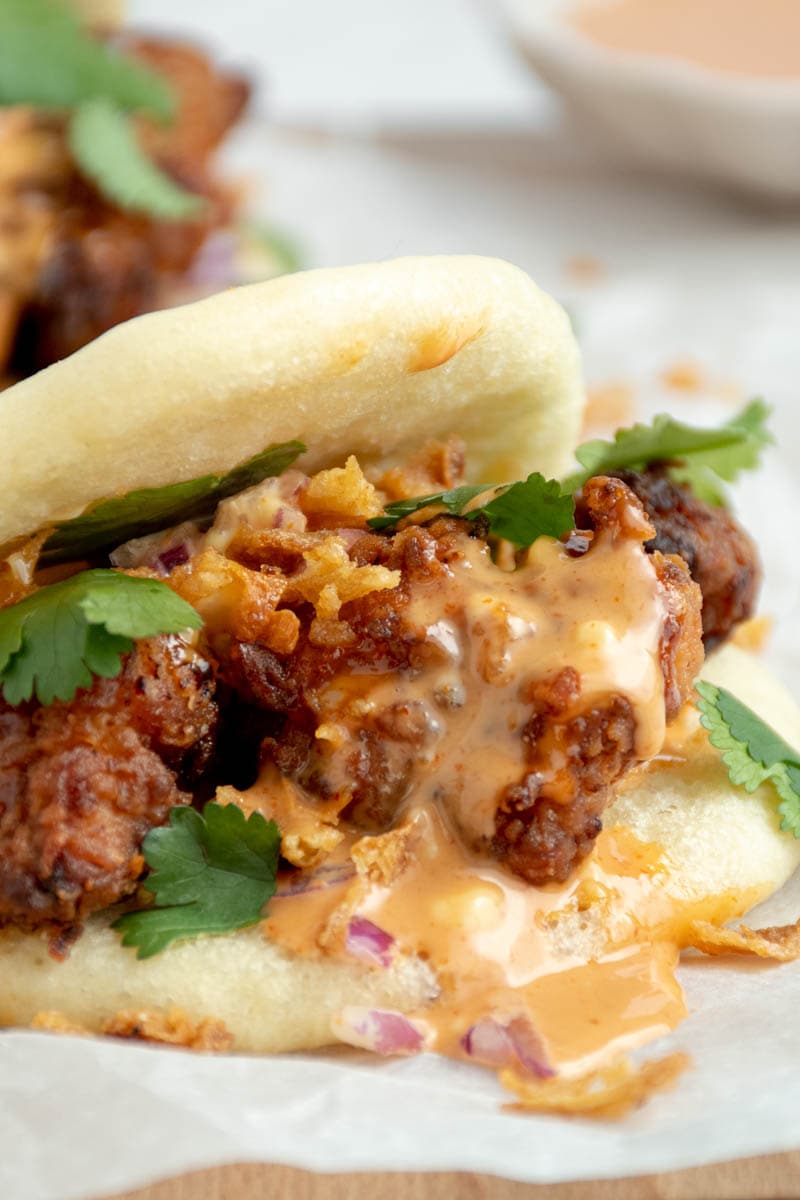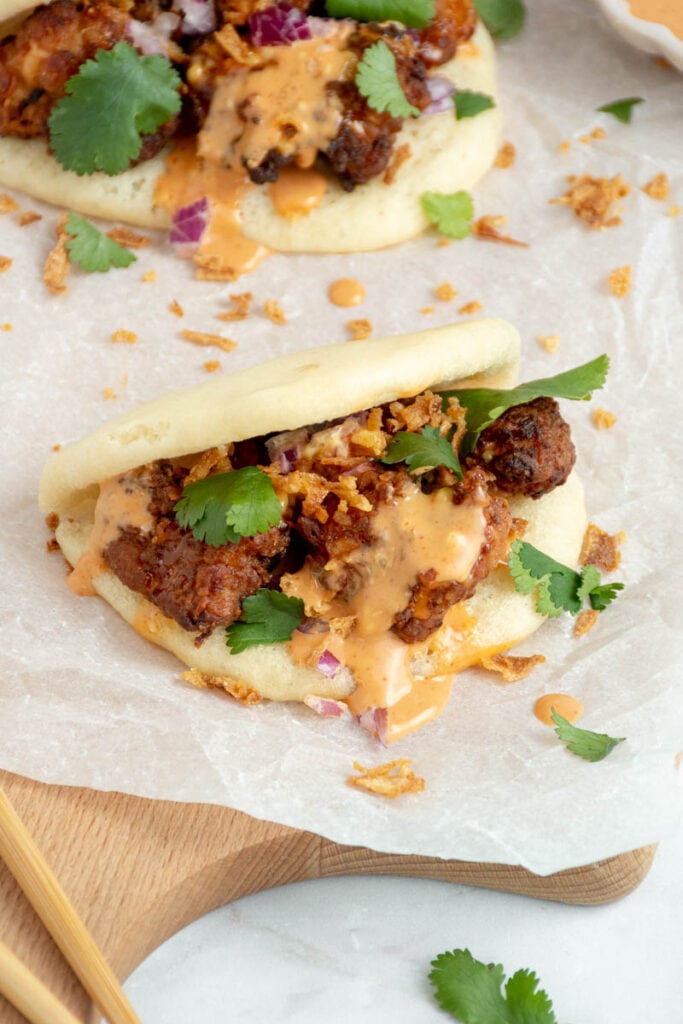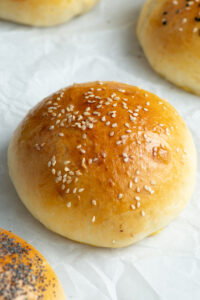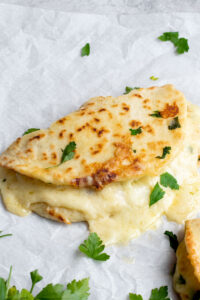This post may contain affiliate links, which means I’ll receive a commission if you purchase through my links, at no extra cost to you. Please read full disclosure for more information.
Bao buns, also known as gua bao, are super soft, steamed Chinese buns. Gourmet and totally addictive, you can top them with anything you like. What's more, they're a welcome change from traditional sandwiches, and are extremely popular with Asian street-food fans!

If you like Asian food, you'll love this Teriyaki glazed salmon, homemade Cantonese rice or these chicken egg rolls.
Table des matières
💙 Why you'll love them
- They are incredibly moist and so delicious.
- You can garnish them with whatever you like, and why not try a burger version?
- They can be frozen for later use: when you're feeling lazy, just take them out of the freezer and garnish them.
🥛 Ingredients
These are the main ingredients, and the quantities can be found in the recipe card below.
- All-purpose flour
- Water. I recommend using it warm.
- Whole cow's milk . Especially not semi-skimmed.
- Fine salt: be careful not to use coarse salt, as it will not melt easily into the dough.
- Brown sugar: don't worry, you won't taste any sweetness.
- Instant dry yeast
- Sesame oil to add a little fat and bind the dough.
- Sunflower oil: when I make the second batch of bao buns, I apply a very light layer of sunflower oil to prevent them from sticking. I've already tried it with sesame oil but it was too strong in the bao. If you don't want to use sunflower oil, use a neutral oil, so that it doesn't over-perfume the dough.

✨ What topping for these bao buns?
My favorite topping for gua bao is chicken Karaage (a super-crispy fried chicken, truly incredible)! I also love spicy mayonnaise, cilantro, fried onions and vegetables: mushrooms, carrots, cucumbers, eggplants, zucchinis, etc...
You can also make them with pork, beef (this beef with onions or the meat from this birria tacos are wonderful in bao), tuna, salmon, etc...

🥰 Chef's tips
- As European, I'm used to working in grams and milliliters. For this recipe, I really recommend using a digital scale, which is much more precise. That way, you'll be sure to succeed with your recipes.
- Knead the dough for the recommended 10 minutes in your food processor: this is what makes the bao so soft. And the dough will be easier to work.
- How to know if the dough has been kneaded enough Press lightly with your finger. If the dough more or less returns to its original shape (not completely), it's done!
- Don't neglect the baking times: bao buns are baked twice (1h30 then 20 minutes), for the softest crumb possible. The second shoot is crucial and must not be prolonged.
- Tip for successful sprouts: I usually put my dough in a bowl and stick some cling film over it. I turn on my oven at 86°F/30°C and once it's hot, I turn it off and open the door for about ten minutes. Then I put the bowl down and leave it to grow (I do this for both sprouts).
- When rolling out the dough, oil the work surface to prevent sticking and make it easier to work.
- It's best to cook them in cold water, using a gentle sim mer: cooking them in water that's already boiling or in a large pot could harden the bao.
- Once cooked, lift the lid slightly and allow the temperature to drop gradually: too much thermal shock could cause your bao to deflate.
- If you're making several batches: while you're baking the first batch, wrap the others in cling film and put them in the fridge, otherwise they'll continue to grow (and risk overgrowing).

❄️Storage / freezing
Bao buns are eaten hot and cannot be preserved.
If you're not going to eat the whole thing, I recommend letting them cool and freezing them. To defrost, put them in the fridge the day before and let them defrost gradually.
😋 Other Asian gems
- Katsu Curry: traditional Japanese curry
- Easy chicken and vegetable gyozas
- Crispy rice, salmon, spicy mayo and avocado
If you make these Bao buns, it would be so nice to leave me a comment and rate the recipe ⭐️⭐️⭐️⭐️⭐️. You can also tag me on Instagram, Pinterest, Facebook or Tik Tok, or even send me a photo, I love seeing my little dishes in your homes!
📖 Recette

Bao buns (Chinese steamed buns)
Ingredients
- 2 ⅓ cups all-purpose flour (300g)
- ½ cup lukewarm water (115g)
- 10 teaspoons whole milk (50g)
- ½ teaspoon fine salt (3g)
- 2 teaspoons granulated sugar
- 1 ¾ teaspoons instant dry yeast (5g)
- 1 tablespoon sesame oil
- sunflower oil
Instructions
- Warm the milk and set aside. Mix the warm water and yeast in a bowl for a few minutes.
- Place the flour in the bowl of your food processor, then add the water and yeast mixture, followed by the milk, oil, brown sugar and salt.
- Knead for 3 minutes at low speed, then 7 minutes at higher speed. Tip to determine whether the dough has been kneaded enough: press lightly with your finger. If the dough more or less returns to its original shape (but not completely), it's ready! If not, finish kneading it by hand for a few minutes. Cover and let rise at 82-86°F/28-30°C (see notes) for 1h30.
- Roll out the dough with a rolling pin (no need to flour the work surface) and shape into circles with a cookie cutter or glass. Shape into ovals, then lightly oil with sunflower oil, before folding in half.
- Place on squares of parchment paper, cover with a clean tea towel and leave to rise for a further 20-30 minutes at 82-86°F/28-30°C.
- Move on to baking: place the squares in the baos basket, close and place over the pan of cold water (very important). Turn on medium heat and simmer for around 17 minutes. Then lift the lid slightly and leave the baos to cool before garnishing and serving.
Notes
- As European, I'm used to working in grams and milliliters. For this recipe, I really recommend using a digital scale, which is much more precise. That way, you'll be sure to succeed with your recipes.
- Tip for successful rises: I usually put my dough in a bowl and stick some cling film over it. I turn my oven on to 86°F/30°C and once it's hot, I turn it off and open the door for about ten minutes. Then I set the bowl down and leave it to rise (I do this for both rises).





Répondre